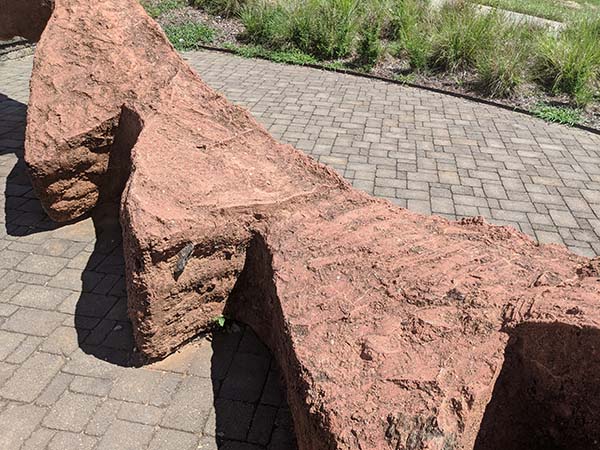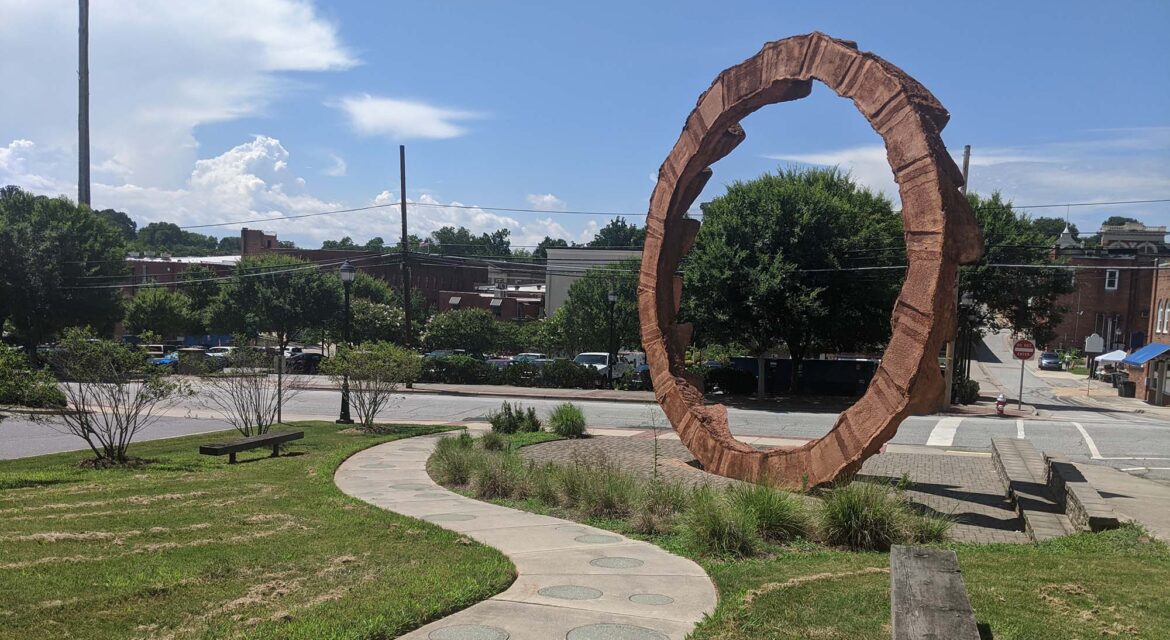Located in the foothills of the Blue Ridge Mountains of North Carolina, the city of Lenoir is notable for several reasons. Named after Revolutionary War hero General William Lenoir, the city would eventually develop a reputation as a world-class furniture and manufacturing hub while also assembling the largest collection of permanent public outdoor sculptures of any community of its population in the United States.
However, these distinctions brought a unique set of challenges for residents to sort through. Recent changes to the furniture industry as a whole saw many of the jobs that supported the town moved overseas, which led to a high unemployment rate in Lenoir. Additionally, many of the sculptures in the city’s public art collection were not designed to last forever. How would these pieces be maintained? Could these pieces be utilized to promote the town to help redefine Lenoir?
These were the issues that sculptor Thomas Sayre helped the Caldwell Arts Council, which has promoted and presented high-quality arts in Caldwell County since 1976, sort through. Originally hired to evaluate the public art collection and come up with a strategy to utilize these pieces, Sayre would eventually be commissioned by the council to create “Across the Grain”, which has come to serve as an anchor tenant of the public art collection while also inspiring the community to simultaneously embrace the past and move into the future.
The Art and Economy of Lenoir
 Thomas Sayre works all over the country for different municipalities, counties and states. This work is typically funded by a Percent-for-art program, but that was not an option for the project in Lenoir. This meant he had to work with Lee Carol Giduz and the rest of the Caldwell Arts Council to find funding for this public art project from private donors. A vision around what doing so could mean to the community saw that support come in very quickly.
Thomas Sayre works all over the country for different municipalities, counties and states. This work is typically funded by a Percent-for-art program, but that was not an option for the project in Lenoir. This meant he had to work with Lee Carol Giduz and the rest of the Caldwell Arts Council to find funding for this public art project from private donors. A vision around what doing so could mean to the community saw that support come in very quickly.
“We ended up getting the whole project funded in two dinner parties,” Sayre mentioned. “The reason it came together that quickly is because people realized that for a modest investment, they could put something out in the public space that proved this community was not going to be defined by the downturn it was experiencing. These individuals saw that what we were trying to do was really going to matter. They decided they wanted to support something positive rather than dwell on something negative.”
That commitment enabled the creation of “Against the Grain”, which is a 26-foot, 40,000-pound earthcast sculpture. The materials and permanence of the piece directly speaks to why the piece has become an icon of the region, but the symbolism it contains runs much deeper and has had a very real impact on the space and the entire community.
Something BIG is Coming to Lenoir
 Within the sight of “Across the Grain” are former furniture factories, while the sculpture itself is located in the spot where the Blackwelder Hospital used to reside, which is where many of the older residents of the town were born. This physical connection to the city is evident, but the symbolism to the timber and furniture heritage that the piece contains runs much deeper and literally tells the story of the past and future of Lenoir.
Within the sight of “Across the Grain” are former furniture factories, while the sculpture itself is located in the spot where the Blackwelder Hospital used to reside, which is where many of the older residents of the town were born. This physical connection to the city is evident, but the symbolism to the timber and furniture heritage that the piece contains runs much deeper and literally tells the story of the past and future of Lenoir.
“The Lenoir community took the harder road and went ‘across the grain’ with the creation of this piece rather than with the grain, because going with the grain would have been languishing in their economic downturn, which would have been easier,” Sayre continued. “You can see that metaphor in the saw-blade shape of the piece, but the shape also alludes to the bike wheel of tourism and the turbine engine of an international airliner that is enabling an evolution of the furniture industry in Lenoir.”
These connections to the past and present are part of the reason the community was able to get involved with and support the creation of the piece in a very tangible manner. In the lead-up to the unveiling, signs and posters with the message of “Something BIG is Coming to Lenoir” were all over the city. These billboards changed as the piece neared completion, creating a palpable sense of excitement across the area. That excitement enabled a direct economic impact as well, with businesses selling t-shirts and coffee mugs that featured the sculpture.
The dedication of “Across the Grain” drew hundreds of people. Linda Carlisle, Secretary of the North Carolina Department of Cultural Resources, was at the event and mentioned how the piece sparks discussion and enables a sense a place, which people can interpret and interact with in countless ways. Doing so has made a real difference that is driving the spirit and economy of Lenoir and all of Caldwell County.
“Why Not Do That?”
 In a video that highlights the creation of “Across the Grain”, Sayre literally asks, “why not do that?” when it comes to building major pieces of public art. In many cases, the answer to that question comes down to restrictions on money, support and time, but these excuses aren’t real answers.
In a video that highlights the creation of “Across the Grain”, Sayre literally asks, “why not do that?” when it comes to building major pieces of public art. In many cases, the answer to that question comes down to restrictions on money, support and time, but these excuses aren’t real answers.
Lenoir is a city with less than 20,000 people, which means stakeholders in the city could have utilized any of those excuses as the reason for not pursuing initiatives like the one that resulted in the creation of “Against the Grain.” Nonetheless, their dedication to the arts enabled the creation of a world-class piece of art that has far more to do with dedication and vision than it does with money or time.
“What I’ve found, over and over again, is that there’s a hunger among human beings for what you might call the ‘spiritual’, which is the purview of art,” said Sayre. “There’s a hunger to support something that makes a statement about a community and speaks to people on an individual and collective level. In the case of Lenoir, that was about Lenoir and the whole of Caldwell County saying they’re not going down. They wanted everyone to know they’re still alive and are going forward. So what’s that worth?”
It’s easy to mount an economic argument that resources utilized to support the creation of a sculpture or piece of public art might be better spent on social services, but “Across the Grain” illustrates what a return on this type of investment can look like in both a tangible and spiritual sense. Given the reinforced concrete and steel building materials, the piece is set to be part of the downtown landscape in Lenoir for countless generations, illustrating just one element of the long-term worth that these sorts of initiatives can embody.

To see more from Thomas Sayre, visit his site: www.thomassayre.com/
